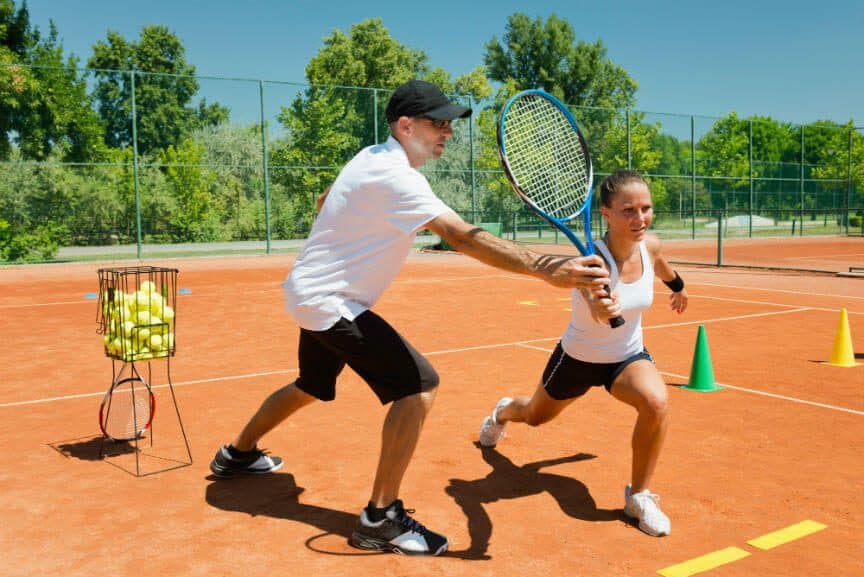You want to continuously improve your game, but maybe you’re wondering how often you need to practice to achieve your goal. Most people will tell you the more you practice the better. There are, of course, limitations to this. You certainly don’t want to overdo it and risk injury.
Practicing once or twice a week should allow you to maintain your current level, but if you are looking to improve you should aim to practice tennis at least 3 times per week. If you can get out a bit more, 4 to 5 times a week, you will put yourself in a position to advance your game quickly. If you practice more than this, you need to be careful with injuries. It’s just as important to allow your body to rest as it is to train hard.
How often you practice also depends on a few other factors that we will discuss next. For example, the time you spend on the courts can make a big difference. So can the intensity of the training or the type of practice, practicing drills on your own, hitting against a partner, or playing matches in a competitive or non-competitive setting.
How Many Hours of Practice Each Day?
If you step out on the courts to practice 20 minutes each day and put in 5 days a week, that probably is not going to be as effective as practicing one hour a day 3 days a week. It takes a while for the body to get warmed up and many of the most beneficial reps come towards the end of that hour.
On the other hand, for those who are looking to compete on a high level, an hour of practice may not be enough. They may need to put in many hours of practice each day, combined with overall conditioning. Along with time spent practicing, those looking to become elite players will tend to practice more intensely.
How many hours you put in each day will be based on a few factors, including how serious you are about becoming a competitive player. Another thing to consider is age. Young children should not be subjected to extremely long practices. Older players will also want to factor this in to prevent injury.
Age Plays a Role
Young children need to engage in free play in addition to sports. They also typically play several sports throughout the year. It’s not until their adolescent years that they begin to specialize in one sport. For this reason, it’s important for children not to overdo training.
A general rule of thumb is that they should not engage in a single sport for more than twice the amount of time they engage in free play. Another general guideline is that they should not engage in more hours per week than their age. So a 10-year-old child would want to dedicate no more than 9 hours per week to practice.
Adults have more liberty in terms of practice time, but keep in mind that as we age our bodies will develop additional limitations and we will tend to be at greater risk for injury. It is possible to overdo it as an adult. Be sure to listen to your body’s signals that it’s overworked. Minor aches can become serious injuries in the long run if you overlook your body’s cues.
One way to avoid this is to take breaks from time to time. A cumulative period of 1 to 3 months usually works well. In addition to rest periods to avoid year-round training, it’s also important to take at a minimum one day per week to rest and recover. Two days of rest and recovery per week would probably be best for most.
How Intense is the Training?
This brings us to the intensity of training. You want to practice intensely enough so that you are consistently improving your game, but as previously mentioned, you don’t want to overdo it either.
As a general rule, if you are putting in very intense practices regularly, you can and probably should reduce the number of hours you practice per week. You also want to make sure you are getting enough rest in between sessions.
It’s important to not only train hard but also do so intelligently. The more focused your practices and the more you target areas of your game that need improvement, the more you will get out of practice.
There are various ways to train. In addition to how often you practice, what type of training you do is important. Ideally, you would want to practice in various ways to learn all aspects of the game.
Hitting With a Partner
Hitting with a practice partner or coach in a non-competitive setting or even practicing with a ball machine is great for repetition, learning new techniques, and getting comfortable with your strokes.
This is a critical part of training which should make up a good part of your practice. You need to practice hitting this way regularly to develop your game. The quality of your hitting partner plays a major role. If you have the opportunity to hit regularly with a coach or professional level player, chances are you will progress more quickly.
However, because you are essentially being fed relatively easy balls, you are not getting the full experience of playing a competitive match under pressure. You are also not going to push yourself physically to the maximum extent.
Tennis Practice Drills
Like hitting against a partner, practice drills are a major part of training. You should aim to incorporate drills into the time you spend practicing. Practice drills involve setting up a specific goal and then executing the shot repetitively.
Examples include hitting shots down the line, crosscourt, practicing serves and returns, volleys, overhead shots, focusing on the backhand or forehand, etc. Practice drills can be made competitive by keeping score, but for the most part, they are non-competitive, similar to practicing with a partner.
Practice drills are good for repetition and development of specific strokes or game situations, as well as improving consistency. However, like hitting against a partner, they do not simulate a truly competitive match environment.
Practice Matches
These are matches you may play with your practice partner or instructor. They involve full scoring and complete match situations but in a low-pressure environment. This is a key part of practicing because it allows you to experience all the various aspects of the game.
Practice matches will allow you to use all your shots in a real game situation. It also allows you to get used to playing against an opponent and improving your match play. Since you are now keeping score, winning points comes into focus. Practice matches allow you to learn how to win points.
Because you are usually playing against an opponent you are used to hitting with, it’s not quite the same as playing a competitive match where you are playing someone you don’t know each time. It’s therefore not a true match environment under pressure.
Competitive Tournament Matches
When you participate in competitive tournaments or matches for your school or club, you get the opportunity to experience true competitive pressure situations. You’ll have the opportunity to play against players you don’t know and experience many different styles of play.
Competitive tournaments allow you to become used to situations under pressure, learning to win matches, and dealing with opponents. On the other hand, you will be more restricted in terms of learning and trying out new things. Like practice matches, you also do not get to practice repetition for development and consistency.
All four of these types of practices are critical to developing as a player. Ideally, you want to experience all of them throughout each year since they each have their advantages and disadvantages. Next let’s take a look at another important variable, training to develop your game vs overall conditioning.
Conditioning vs Training
Practice can either focus on training to improve your strokes or on conditioning. While there is usually an overlap of the two during training, practice can be specifically focused on improving conditioning either through strength training, resistance training, plyometric exercises, running, footwork drills, etc.
How many times you practice per week needs to also factor in this type of training. For example, if you do conditioning-specific training once or twice per week, then you would need to add 3 days dedicated to improving your game, i.e., your groundstrokes, serve, approach shots and anything else you need to work on.
Add to this non-competitive practice matches or competitive tournament play and you are looking at about 5 days of practice per week: 3 days dedicated to improving your game and 2 days dedicated to conditioning.
Final Thoughts
As you can see, there are many factors and many variables that determine how much you should practice per week. Everyone is different and has different goals or reasons for playing tennis. However, at a minimum, you need to practice at least 3 days per week to see a steady improvement in your game.
Once or twice per week may cut it if you’re an absolute beginner, but you will begin to plateau after a while and no longer see any improvement in your game. The goal should be to continue to improve the longer you play and that will likely require more practice as you progress. Just be careful not to overdo it.
Share this Post

